Every Car Had a Mascot
by Bob Brooke
QUESTION:
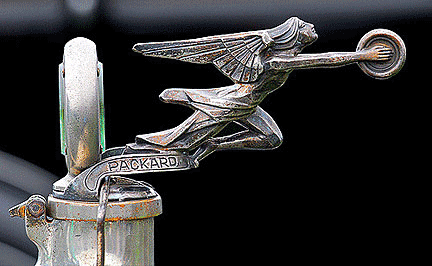 Way
back when, my grandfather owned a 1925 Packard. My father says he loved
that car, so much so that he removed the hood ornament from it and kept
it as a souvenir when the car no longer worked, and he took it to the
junkyard. He gave it to my father, who, in turn, gave it to me. It now
sits proudly on my desk. It’s a real beauty, but is it worth anything or
am I just being sentimental? Way
back when, my grandfather owned a 1925 Packard. My father says he loved
that car, so much so that he removed the hood ornament from it and kept
it as a souvenir when the car no longer worked, and he took it to the
junkyard. He gave it to my father, who, in turn, gave it to me. It now
sits proudly on my desk. It’s a real beauty, but is it worth anything or
am I just being sentimental?
Thanks,
Charles_________________________________________________________
ANSWER:
Your hood ornament, a Packard
cormorant, is something very special. If you haven’t
noticed, cars don’t come with them anymore. At the time your
grandfather owned his car, hood ornaments were all the rage.
Every car had one—some were extremely elaborate, more like
works of art.
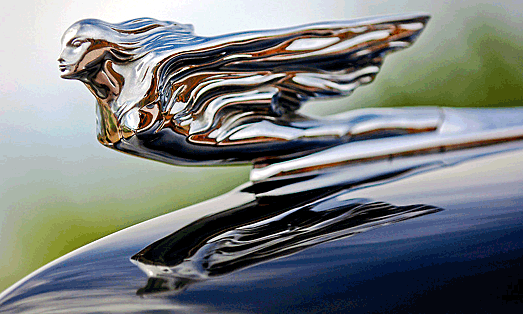
Collectors refer to these hood ornaments as automobile
mascots. They began as radiator caps at the turn of the 20th
century. Automakers added decorative touches to
differentiate their vehicles from others during an era when
there were 3,000 automobile manufacturers in the U.S. There
are now only a handful.
Back when drivers had to negotiate muddy roads and weren’t
sure if they’d get back home, St. Christopher, the patron
saint of travelers, supposedly brought them good luck. He
also protected them from robbers, who prayed on unsuspecting
motorists. If you owned a car back then, you had some money.
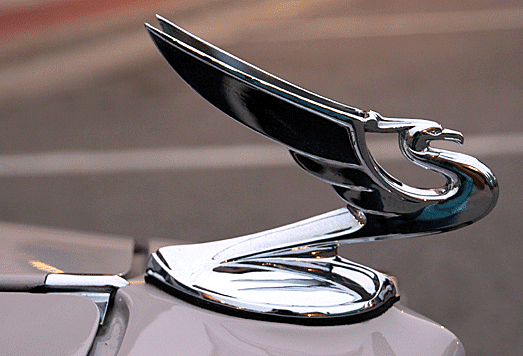
Birds, chosen by auto makers to convey quick flight, became
a common ornament theme. Packard chose a cormorant. Ford
chose a quail for its Model A’s and Duesenberg, a stylized
bird.
Many collectors consider the stork, used by European
automaker Hispano-Suiza, to be the most distinctive and
collectible. The stork commemorates French World War I ace
Joseph Vuillemin, who had a stork painted on his airplane.
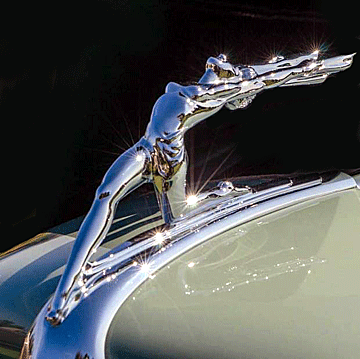 Some
auto makers chose to use graceful ladies. Moon Motor Co., a
now defunct St. Louis manufacturer, had the Greek goddess
Diana on its cars to appeal to women. The glass lady hood
ornaments crafted by Lalique before World War II are worth
$1,000 to $10,000 depending on subject matter, condition and
rarity. Some
auto makers chose to use graceful ladies. Moon Motor Co., a
now defunct St. Louis manufacturer, had the Greek goddess
Diana on its cars to appeal to women. The glass lady hood
ornaments crafted by Lalique before World War II are worth
$1,000 to $10,000 depending on subject matter, condition and
rarity.
Bugatti Royale selected an elephant balancing on a ball to
demonstrate agility. World War I ace pilot Eddie
Rickenbacher used an airplane mascot before his auto
business failed in the 1920s. Chevrolets also sported
airplanes in 1932. Designers for the Lincoln chose a
greyhound mascot to dispel rumors that the auto was slow.
Some mascots invented in that time still exist, including
Mercedes-Benz's three-point star and the Mack Truck bulldog.
The height of hood ornament use was the 1920s and early
'30s. By the mid-'30s, they began to fade as the Streamline
Moderne movement, which emphasized aerodynamics and eschewed
features that slowed down vehicles, caught on. But Mercedes
held on to its mascot anyway. The company cared more about
prestige than it did aerodynamics.
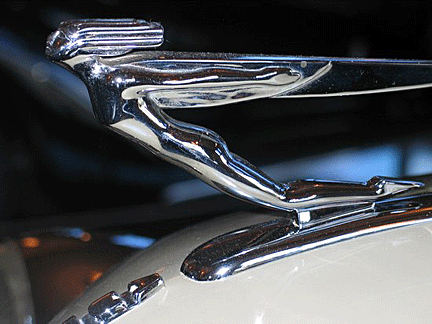 Other
ornaments, such as Cadillac’s Lady, Rolls-Royce’s Flying
Lady, Packard’s Cormorant, Desoto’s Explorer and Imperial
wings, lasted through the 1950s, though they were much
smaller than their predecessors. Other
ornaments, such as Cadillac’s Lady, Rolls-Royce’s Flying
Lady, Packard’s Cormorant, Desoto’s Explorer and Imperial
wings, lasted through the 1950s, though they were much
smaller than their predecessors.
Collecting hood ornaments began in the 1940s when the owners
of great old cars like the 1920s Rolls and Packards began
scrapping them. Some of the first collectors visited
junkyards, armed with screwdrivers and pliers, to hunt for
mascots among the wrecks, for which they paid a dollar or
so. Today, it’s almost impossible to find them in
junkyards—junkyard owners know their value. Today, a typical
Chevrolet mascot from the 1950s costs $100.
<
Back to Readers Ask Archives
Next Article > |
